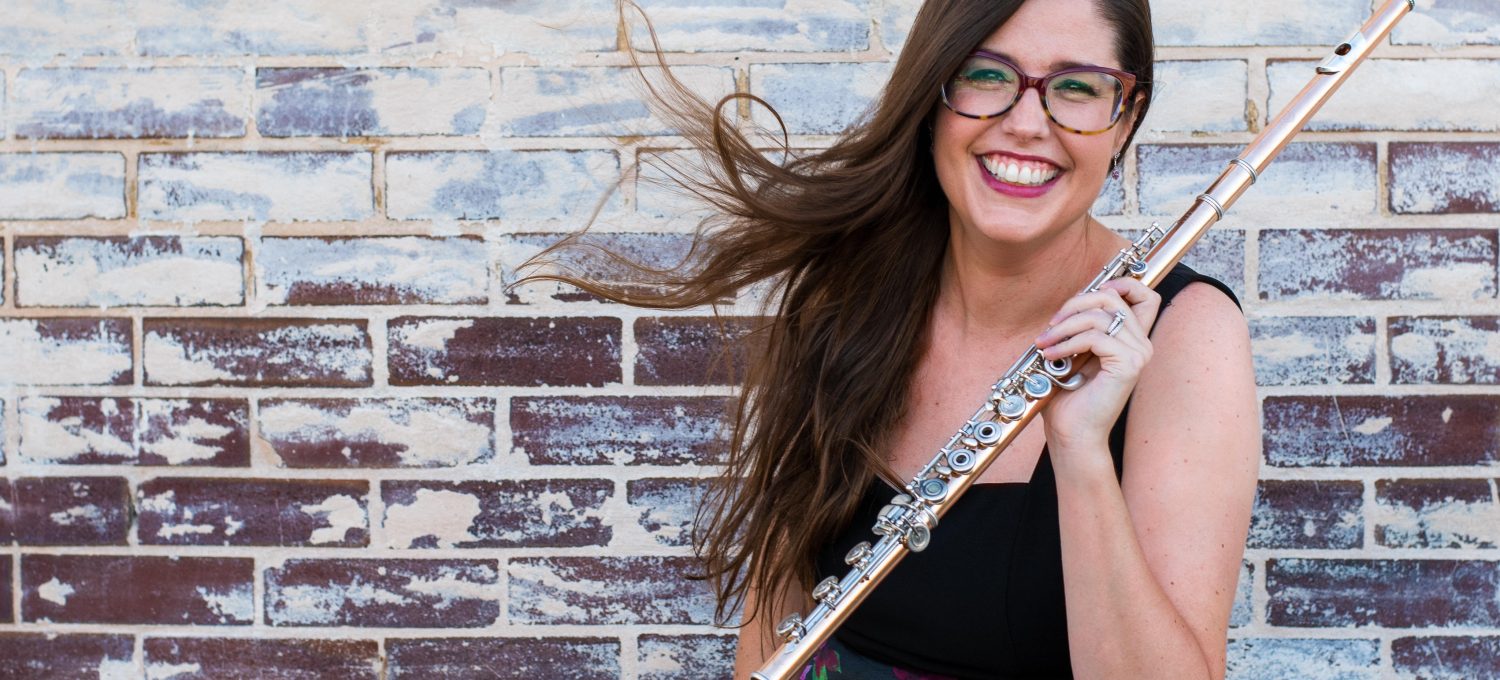Confession time: I know Mary Matthews. When she moved to Tennessee to be the professor at Tennessee Tech, we met and became friends. Quickly, she turned into someone whose scholarship, pedagogy and playing I respect and admire even more than the simple pleasure of our friendship. In Fall 2023, she moved away to Tallahassee, FL to become one of the flute professors at Florida State, which happens to be one of my alma maters! I am thrilled to bring this interview to the Flute Examiner.
JD: I literally always start with the same question, because I think this is a very interesting part of everybody’s story. What drew you to a life in music? How did you get here?
MM: Well, I think that my life in music goes back very far. I started playing the flute when I was six years old, which is unusual, especially for non-Suzuki students. I went to this really tiny private catholic school for elementary school, and they had a band – but it was maybe twelve people and it included violin, guitar and recorder! When I played recorder in general music class in first grade, my teacher said to my parents, “She really takes to a wind instrument. She should play the flute or the clarinet next year.” And I thought the flute was shiny and pretty!
JD: Don’t we all!
MM: Don’t we all! And so I picked flute, and it was really the first activity that I ever did that I just completely fell in love with—and the first subject in school I really fell in love with. That was the first thing I remember being really excited about. I was very lucky, because I grew up in Rochester, NY, and so while no one in my immediate family was involved with music, I had incredible public-school music programs and music teachers to point me in the right direction. My band director in middle school said, “Mary should take flute lessons,” and my mom and dad said, “Well, I thought you were teaching her flute lessons?”
So they learned the difference between private lessons and band class, and thankfully my band director referred us to a flute teacher at the Eastman Community Division. It was my teacher there, Jan Angus, who got me involved in youth orchestra, flute choir, music theory classes and the diploma program. With every new opportunity through Eastman and youth orchestra, I loved music and flute more and more. My mom was a career counselor, so I was always very lucky to have her advice and guidance. One day while we were driving home from youth orchestra she said to me, “You know, you could do this in college, and for your job,” and I was like, “I CAN?” I was maybe in 11th grade when we had that conversation, and I just never…there was never anything else that I ever considered.
JD: Same here—there was never anything else that I wanted to do.
MM: Yeah! It was just the way. It wasn’t an activity my parents or brother did, so it got to be fully mine, you know. I would practice because I decided to practice or not, or pursue an opportunity because I decided I wanted to. It was never something I was being forced to do or pushed into, and my parents just supported me and learned along with me as we went. So that’s when it started, our family joke—my mom always said, “You should keep going until someone who knows more tells you to quit.” Well, no one has told me to quit yet, so I guess I’ll keep going!
JD: Don’t hold your breath waiting for someone to tell you that!
MM: For undergrad I went to Baldwin Wallace Conservatory of Music where I got to study with George Pope. My high school teacher had recommended him, and there were actually several flutists from the Rochester area who had gone to BW and they loved it. The school is undergrad only, so what was really nice about that is that I got to take on a lot of leadership roles and principal positions as a junior or senior in undergrad.
JD: You didn’t have to compete with grad students.
MM: Yes, so it was a nice opportunity to really explore a lot of different things. I started as a music therapy/performance double major for about a semester, and then I realized that the performance route was more for me. It really was a small enough school to allow me to explore and try some different things. I settled on performance as the right choice, but this is also when I started doing a little bit of teaching. I directed a handbell choir at a church in the community for a small scholarship. That handbell choir was I think the first formal music teaching I ever did. I also started helping friends who were taking woodwind methods at BW with flute, and I think that was the first kind of informal flute teaching I did. And then, just learning about pedagogy from Mr. Pope, George—it was really wonderful having such a great pedagogue as my undergraduate professor because I learned so much about teaching and nurturing undergraduate students from him.
I went to Peabody for my Master’s degree. Right when I moved to Baltimore, I knew I wanted to start teaching flute privately, so I applied to a whole bunch of private lessons schools both in Baltimore and DC, and that’s where I first started teaching flute officially. I got a job teaching at the International School of Music, in Bethesda, MD and I taught some students privately from our house in Baltimore. By the time we left Maryland, I had about 40 flute students. In addition to high school and middle school students, I had some adult students, people who were coming back to the flute after careers in other things—it was a nice variety.
JD: What do you love the most about teaching?
MM: I love so much about teaching! I think my favorite individual moments are of course the “AHA” moments in a lesson—the moment when they get something or they do something that they’ve never done before and they make that face—it’s my favorite thing about teaching. And we clap together and say, “First we’re going to do a little happy dance, because that was amazing! And then we’re going to write down what you did!” So that’s always exciting. I also really love—and this is something I think I got from my mom and her job—meeting new people, learning about them and their goals, and making suggestions about what they should do in their careers. I feel like that’s the most exciting, challenging, and rewarding thing about teaching—getting to know this individual in front of you and envisioning their future. What makes them special? What makes them tick? What are they good at, what makes them excited, and what do they hate? Together, can we figure out how to balance a music career in such a way that they’re going to be fulfilled for the long term and not get burned out. I just love getting to know each one of them, and then figuring out exactly which thing will be perfect for them—it’s so exciting! And so, when I’m reading about different flute opportunities or I’m reading an article or reading about a concert, I always think about my students. I think “Oh, I need to send this to Sarah, or I need to tell Rachael about this.” There is nothing better than watching them discover their unique gifts and exploring those fully.
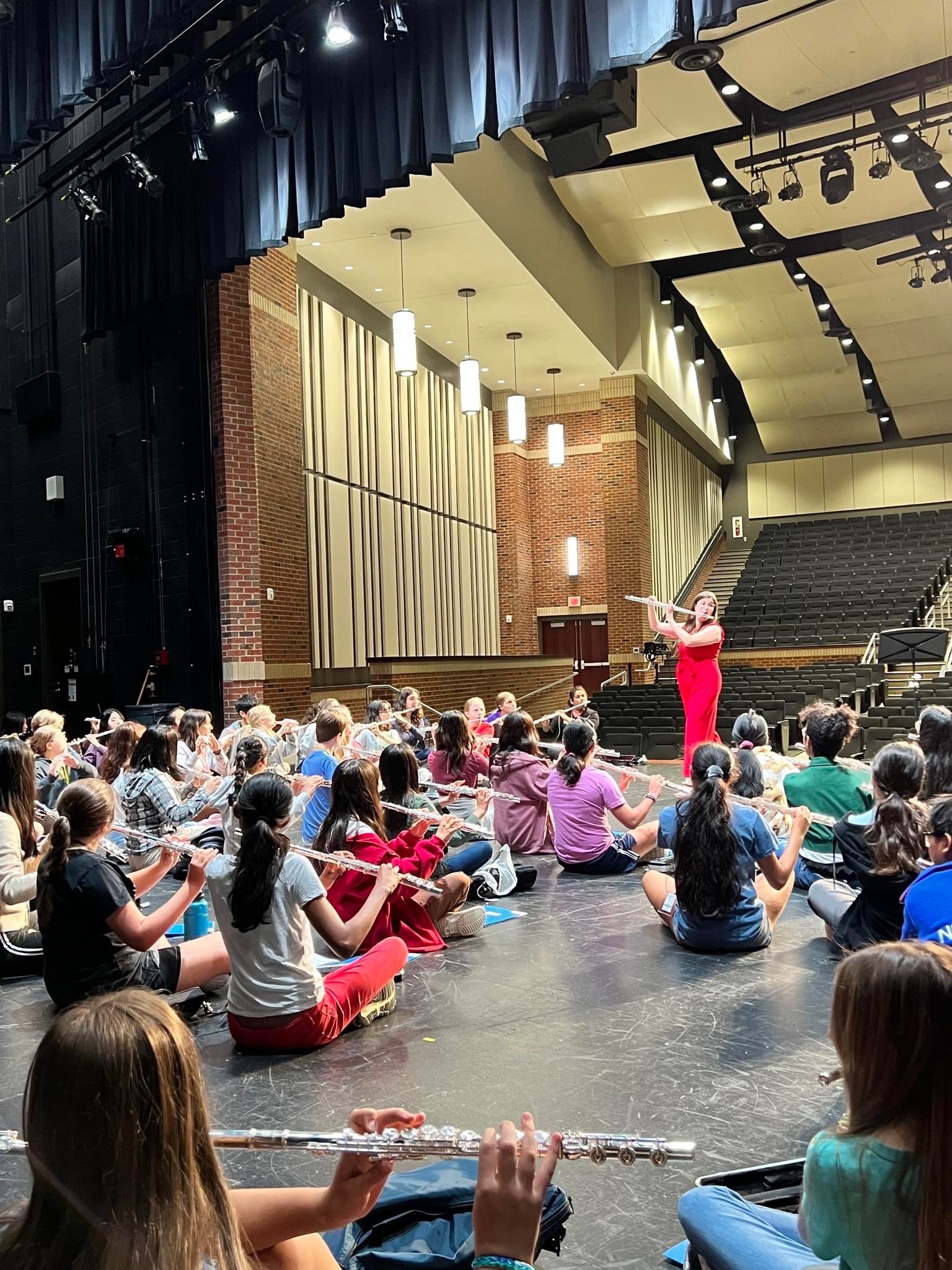
JD: Because it should be personal. When it’s most functional, when it’s at its best, it is intensely personal.
MM: It is. It is! And I really do believe that there is a space in music for everyone who wants to pursue this life. It’s just about finding what you can uniquely give to the music field or the flute community and pursuing that. And I just feel like it’s my job as their teacher to help them figure out what that thing is and nurture those gifts. With older students, once they have the tools they need, it is our job as teachers to just point them in the correct direction and let them soar.
JD: I would say that you are a proponent—even a crusader—for modern music. What inspired you to pursue that side of our repertoire?
MM: You know, what’s so funny is that when I was in undergrad, I mostly wanted to play Baroque music. We had a large Bach festival at BW—the oldest collegiate Bach festival in the country—and I would always say, “Bach is my favorite composer!” And he still is one of my favorite composers. So, new music was something that I really started exploring early in my Master’s degree, and I started with contemporary chamber music. I was playing in a flute duo and a wind quintet, and one of my chamber music coaches at Peabody was the violinist in Alarm Will Sound, Courtney Orlando. I was really inspired by her, the ensemble, and her rep suggestions. This was when I was first introduced to Jennifer Higdon and people who are to this day some of my favorite living composers. This is also when I first started exploring extended techniques kind of informally. I wasn’t working on a lot of really contemporary music in my private lessons at the time, but I was exploring a lot of chamber music that included extended techniques.
It was right after I finished my Master’s degree, I think it was 2010, that I met Nicole Chamberlain. She cold emailed my flute duo and said, “I have this piece, Chatter. I completed it but I don’t have a premiere date set. Will you consider premiering it?” We had just been invited to perform at the International Alliance for Women in Music Congress, so we said, “Sure, we’ll premiere it there!” If you’ve played Chatter, you know that the piece includes a lot of pizzicato tonguing, flutter tonguing, jet whistles, and more. At the time she sent us the piece, I had never learned how to pizzicato tongue. I learned how to do that technique for her piece, so I really do credit her and that performance for learning a lot about extended techniques. After that initial collaboration, we really enjoyed working together, and more generally, I enjoyed working with and collaborating with a living composer. It made me want to do a lot more of this and keep adding music to the repertoire! I think it is important that we amplify composers who are living and writing music now. So I love new music not just because it’s fun to perform and to teach but also because I want to bring music into the world that all of us can perform. With that in mind, I think a lot about practicality when commissioning. How can I commission something that will get a lot of play, that will be accessible to a lot of people and inspiring to a lot of people, too? How can we make contemporary music palatable for audiences and people of different ages?
JD: I think this is a good era for contemporary music, because—I’m a little bit older than you—and when I was learning how to do it as a student at FSU, our graduate studio recital in the fall was always pieces with extended techniques. So I got there and my very first semester I was learning Carter’s Scrivo in Vento, And the second year it was Berio Sequenza for me. Those pieces are so dry compared to Nicole’s music, compared to Jennifer Higdon’s music, compared to so much of what we have coming at us now, and I love it when the techniques are in there but you can tell why. It’s not just to make you do a thing. It’s to make the texture sing. It’s to make something come to life that wasn’t quite as alive before.
MM: Right! And I like to share all of this music with students, too. I also tell them – and this really extends to all time periods—just because you just dislike one piece, or one technique, or one composer’s music, does not mean that you hate all contemporary music or all Baroque music. Don’t put yourself in a box. Just because you dislike one piece doesn’t mean you dislike contemporary music. And, just because you’re good at extended techniques, it doesn’t mean that you can’t be good at Baroque ornamentation and Baroque flute. I think it’s great to specialize eventually if that is the best path, but I never encourage students to limit themselves or specialize too soon. A fulfilling music career can include many genres and techniques!
The other thing I really love about playing contemporary music but haven’t mentioned yet is the ability to call, email or text a composer and have a conversation. I love talking about the music and learning about it from their own words and experiences. When we began working on a Khemia Ensemble commissioning project 2 years ago for our album Intersections, Dave Biedenbender emailed me and asked, among other things, “How many jet whistles can you play in a row?” And I said, “Let’s find out!” and I grabbed my flute and ran upstairs and just tried it out. So I emailed him and said, “I think I can play 12 without getting too dizzy!” On that same album, Nicolas Benavides wrote this beautiful piece called “Little Cloud,” that begins with ambient nature sounds—making it feel like you’re sitting under a tree at his childhood home, and I was supposed to mimic the sound of a paloma. So he sent me a recording of this bird on YouTube and we discussed how best to recreate that sound. I was just sitting with my headjoint only, and I was fluttering and experimenting with different aeolian sounds and pitches, and together we figured out how to recreate this sound on the flute. I just really love that whole process. I think it brings so much more to my interpretation of the piece, and then when I am talking with the audiences about the music it’s exciting, because I can share these stories.
JD: Again, it’s personal.
MM: It’s personal!
JD: How do you balance? You are one of the busiest teachers I know and you’re also one of the busiest performers I know, and a traveling performer, too. How do you make that work?
MM: I would say…I think we can all agree that a life in music is a constant, every month, every semester, every year balancing act. It’s reassessing how the balance worked or did not work each year. And I think when it comes to my teaching, it’s just incredibly important to me to be a very present, supportive teacher. I want my students, even when I’m traveling, to feel like they can still email or text or call if they have an issue. I don’t like being away for too long at a time during the semester because I want them to feel supported by me. At the same time, it’s important for me to be an active performer, not just on a personal level because I love performing, but also to show my students what that looks like—what a career in music can and does look like. But I’m also really open with them and have conversations about this balance. Last year, I said to a student who is a performance major, “I don’t think I’m going to do any more 6:00 a.m. flights home and then teach at 9:00 a.m.” I told them why and what I was struggling with in order to maintain that schedule. I let them know that I don’t have it all figured out perfectly, and I hope this openness will give them insight as they envision their own future careers.
I will say, in my nature, I’m a workaholic in both my teaching and performing, and my husband is the person who 100% helps to balance me out. I’ll have conversations with him where I’ll say, “I want to do this, this, this and this, would it be crazy?” And he’ll say, “I think you’re going to be really stressed out if you do that.” Then we talk through which things I should pursue and why, and what I’m going to be most excited about. He’s really my sounding board for, “Am I doing more for the sake of more, or is this really going to be meaningful for me or my students in some way?” It helps that he is also a professional musician with a doctorate in music, and we went through four music degrees together. So at this point, we have 15 years of practice trying to balance two careers in music. I also have a wonderful group of close friends in music, and we constantly give each other honest advice about life balance and when we’re doing too much.
I do feel like balance in academic life is struck because of summers and winter breaks. During the year we are just really, really busy performing and teaching and doing it all at the same time, so I do try my best to make sure that I have some down time during breaks. Work/life balance can come seasonally, even it doesn’t come every day. I feel like I’m getting better at saying, “Maybe not right now, but how can we do this at another time?” and that’s where I think I’m growing in terms of long-term balance. I am learning that I can still do all the things I want to do, but I don’t have to do them all right now. But at the same time, especially being in a new place right now, I think I’m saying yes and taking on a whole lot of things, just to have those experiences for the first time and to see how it all works. I also try and make sure that I’m not just balancing teaching with performing work, but that I’m also making time for my family and things that are outside of flute. I missed NFA this year for the first time in a while to go on an extended family trip with my dad and my husband, a two-week trip that we had been planning for years. I remember when I was talking to my husband about it, he said, “You know, you’ll go to lots of NFAs, but I feel like this is the one time we’re going to do this trip with your dad. I think it’s ok to miss NFA this year.” But I needed him as a sounding board to say it.
JD: What are you looking forward to coming up?
MM: Oh, boy! So many things! First and foremost, I am so excited to be getting started at FSU and working with Karen Large—she’s incredible and I already love having her there as a collaborator. I think I’ve always worked best when I can bring friends together, because I’ve always been of the mindset that two heads are better than one, and seven heads are better than two! I worked in a flute duo early on in my career and I’ve worked closely with Nicole Chamberlain for over ten years, and I just love that now I have this wonderful collaborator in teaching also. I’m very excited to be working with her. We have 40 students in the studio this semester who I am enjoying just getting to know right now. Last week was the first week of lessons, so I got to say “Tell me about yourself. Tell me about your dreams and goals and how I can support you.” And I’m loving all of my new performing here, too. I’m playing with the Tallahassee Symphony now and I have upcoming concerts with Tallahassee Ballet and Community Choir, so it’s just a whole lot of new and exciting!
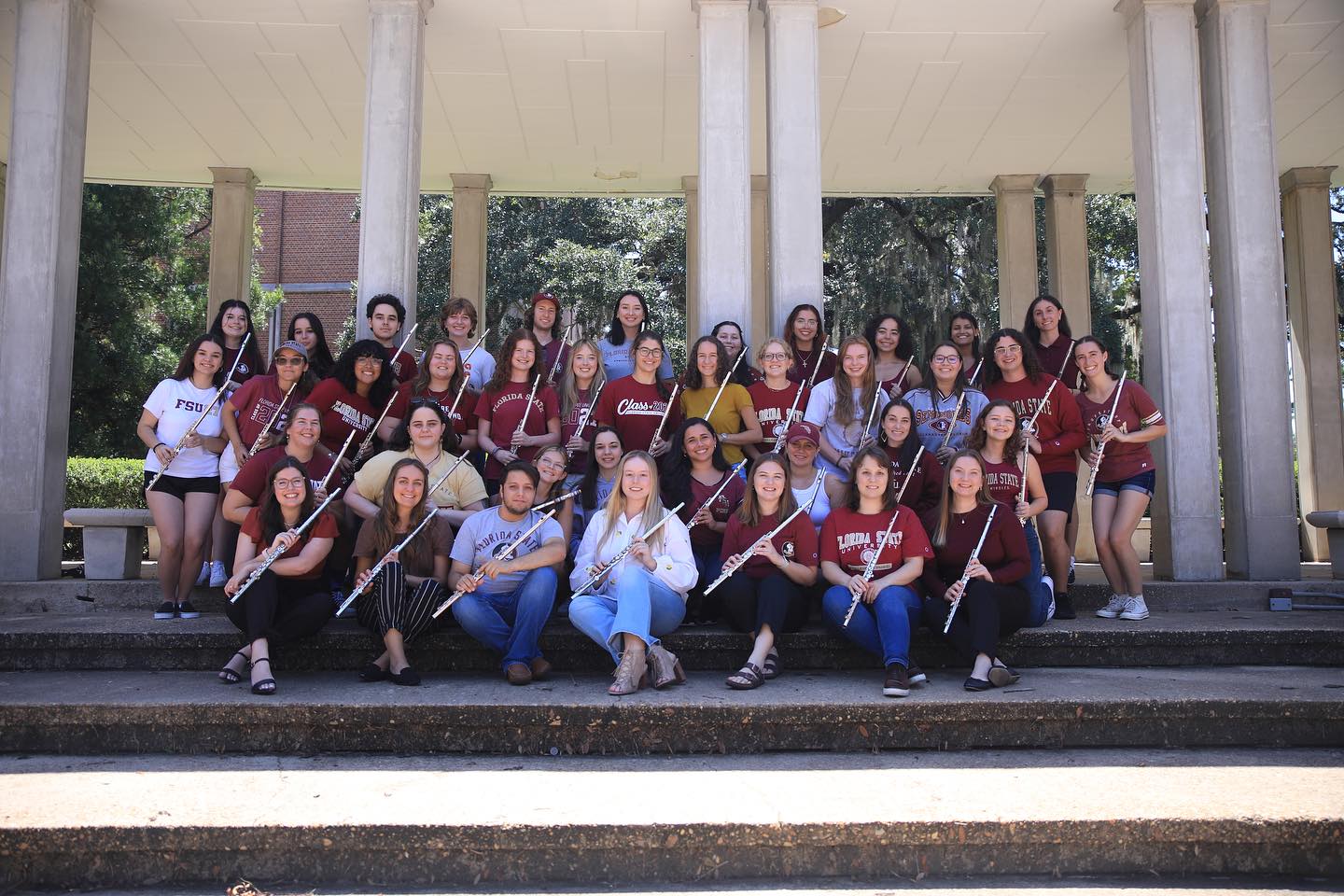
As far as my long-standing projects, I’m a member of Khemia Ensemble, that’s my contemporary chamber ensemble. We have two residencies coming up this year where we’re going to be premiering all of our most recent commissions. I love sharing new music, and we’ve been workshopping these pieces for a long time and now we finally get to bring them to the public. And then Nicole and I just finished our second method book. We’ll be releasing that on October 14!
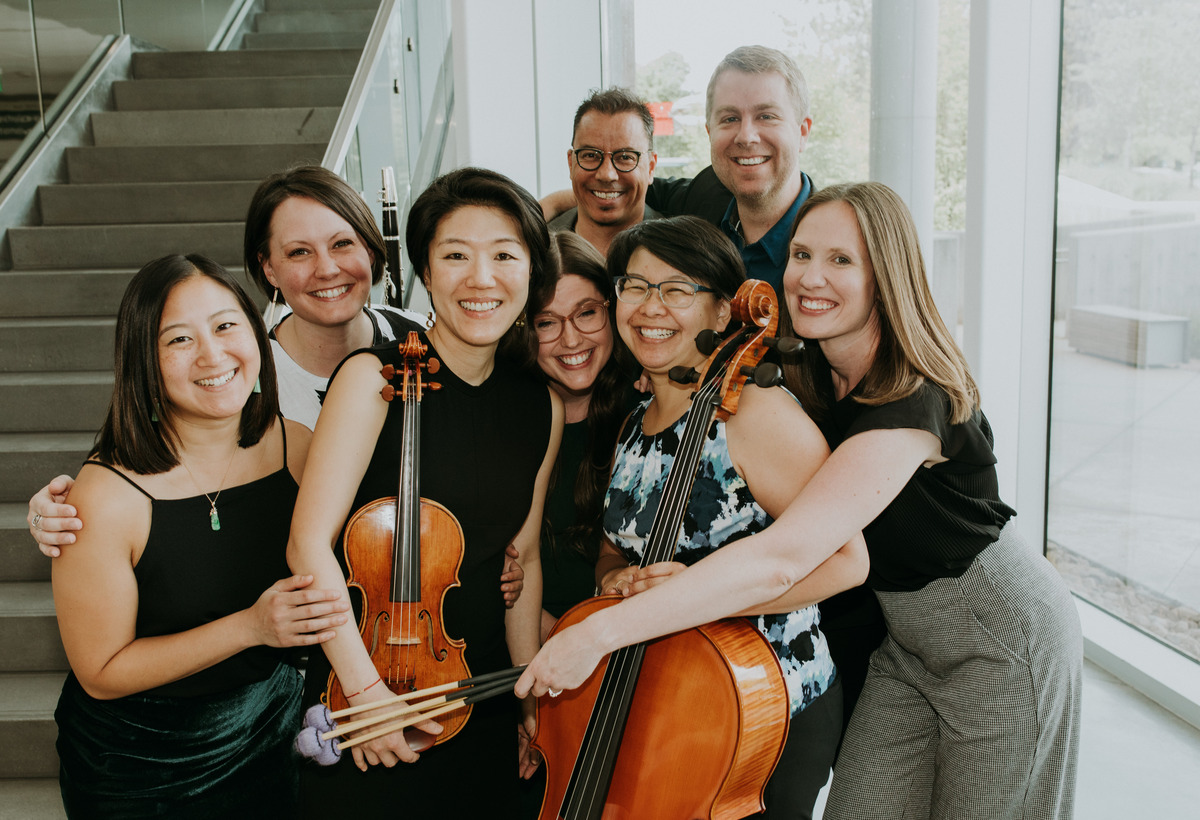
JD: I loved the first one so, so much, and it has been so helpful because you guys did something that not many other texts do, and you actually explained how to do the thing.
MM: Thank you for saying that! That was my goal. I am a very student-centered person and when I wrote it, I kept asking myself, “What do my students need?” and “What resource do I need or want as a teacher?” and that’s what I tried to put in that book.
JD: OK. One more question! Or actually two…here’s another question I always ask: what advice do you have for young people wanting to enter the field?
MM: Well, I think…I mentioned this earlier, but I do think it bears repeating in the advice column. I really do believe that there is a path in music for you if you are a creative thinker, if you’re hard working, and if you have the grit and tenacity to not quit when it gets hard.
JD: Because it will.
MM: Because it will, yeah. And so it’s certainly not easy to get into music, and it’s not always fun and beautiful and exciting, and so whenever I have a student say, “I’m feeling some burnout,” or “It’s not fun right now,” the advice I always give is, “You know, I don’t think anything in life, any activity or any career or any person, even—is fun 100% of the time, even when we have the love for it.” Instead, we have to ask, “Do I love it enough, care for it enough, that it’s worth working through the lulls and difficulties?” And if the answer is yes, then let’s work through the hard times. And if the answer is, “No, I genuinely don’t love this enough to deal with the lows,” then that’s when it is actually good to consider something else.
JD: As someone who teaches primarily pre-college students, the thing I’m always saying is, “Music doesn’t have to be all of your life to deserve a place in your life.”
MM: Yes. And one of the other lines, when I’m working with high school students especially, I say, “I’ve never met a person who regretted sticking with music, and I’ve met so many people who regret quitting.”
JD: What do you like to do for fun?
MM: I love traveling. We’re a family of campers and road trippers. When my husband and I were living in Boulder, CO, for the holidays, we would get in the car in Colorado and road trip to my family in upstate New York and then road trip to his family in Alabama and then road trip back to Colorado. We would camp and hike along the way. We have fun and we always bring our dogs. I’m a die-hard animal lover. We have two dogs and two cats that are all rescue babies and if I lived alone, if it were just me, I would probably rescue every animal and have a house full. But again, I am lucky to have my husband Brandon there to keep the balance in that way too! I grew up with up to seven pets at a time, so I am used to a house full of animals. There was a time early on when we were dating when we had five or six pets because I would do things like come home with a rabbit that was going to be sent to a kill shelter. Our pets are a big part of our lives and our family, so we always make sure that if we’re going to be traveling, if we’re going to do a long trip whether it’s for music or for vacation, that we can find a way to bring them with us as much as possible.
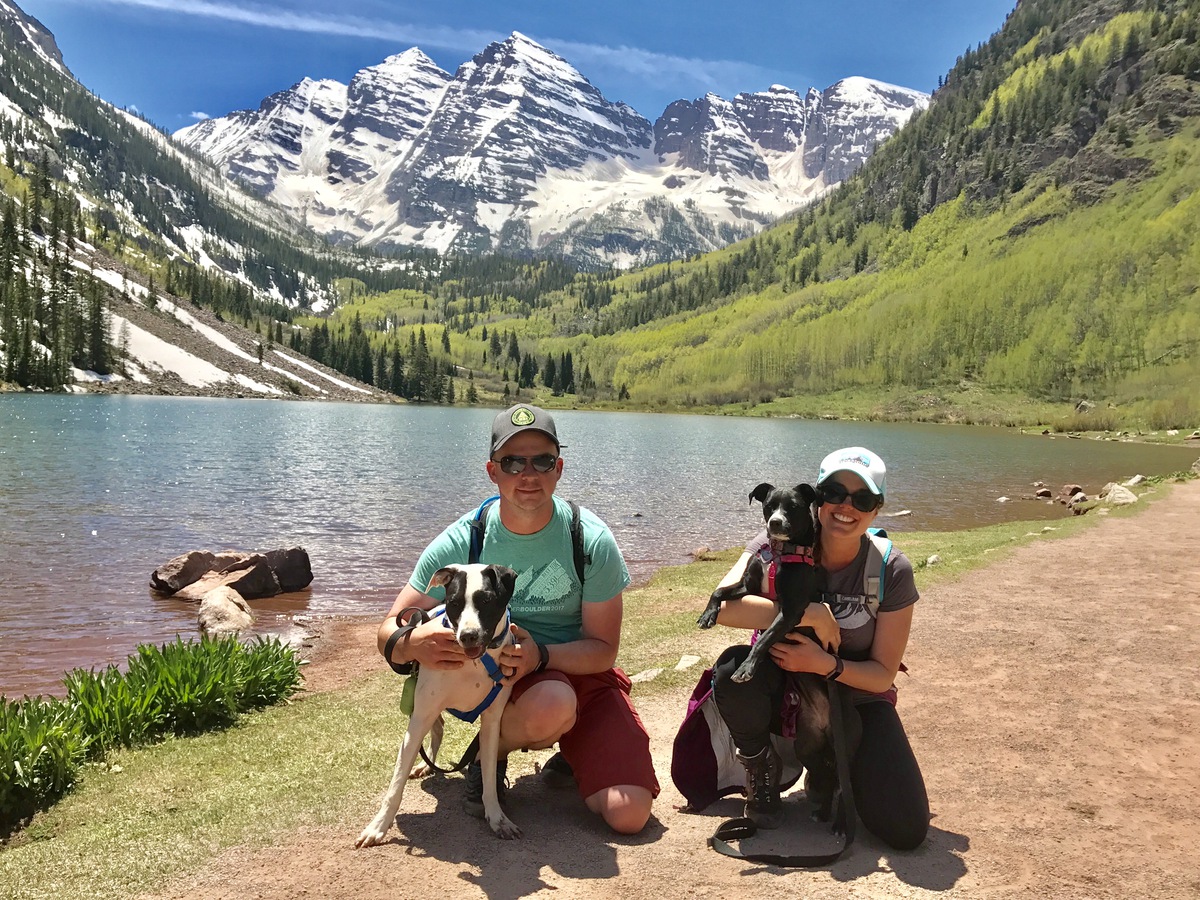
Also, and this is fun because I’m living in Florida now, I was raised as a Disney kid and never grew out of it. I have run the Disney princess half marathons with music friends and take trips with family and friends, and now I get to take advantage of the in-state annual pass!
JD: You know, I felt like I knew you before this conversation but I just feel like I know you better now!
Bio: Flutist Mary Matthews enjoys an active career as an international soloist, chamber musician, orchestral flutist, and pedagogue, and has performed on four continents in venues such as Carnegie Hall, Severance Hall, the Sydney Conservatorium of Music, Fundação Universidade do Sul de Santa Catarina, Festival Goethe Institut Música Nueva, and Cité Internationale des Arts. Dr. Matthews is Assistant Professor of Flute at Florida State University’s College of Music, and prior to her appointment at FSU, she served as Associate Professor of Flute at Tennessee Tech’s School of Music. She currently serves as second flute of the Tallahassee Symphony, and she performs regularly with orchestras such as the Nashville Symphony, Knoxville Symphony, and Chattanooga Symphony, among others.
An active studio musician and recording artist, Mary can be heard on soundtracks for film, TV, and video games on Netflix, HBO, and Disney. She has released four albums including Intersections on the Ravello Records label, Three-Nine Line on the MSR Classics label, Charuhas on the Naxos Label, and Preludes & Recitations on the Tonsehen Records label. She has a fifth album forthcoming in 2023 with the Maryland Chamber Winds.
A sought-after performer of new music, Mary has premiered over 50 new works. She is known for her command of extended techniques and her adventurous programming. She is half of Duo Rossignol with soprano Hillary LaBonte, and the two have been featured at Carnegie Hall’s Weill Recital Hall, the New Music Gathering, the Dairy Arts Center’s Soundscape series, and the National Flute Association convention. She also performs as a member of Khemia Ensemble, a 12-member ensemble dedicated to the programming of diverse and innovative repertoire. Khemia Ensemble is 2023 winner of the Chamber Music America Classical Commissioning Grant with composer Anuj Bhutani. They have been featured at venues and festivals including National Sawdust, the Mizzou International Composers Festival, Strange Beautiful Music, New Music Gathering, Latin IS America, the Missouri Summer Composition Institute, and the Biennial New Music Festival in Córdoba, Argentina. Passionate artist educators, Khemia has also held residencies at more than a dozen universities in North and South America.
Dr. Matthews has been invited to speak on various research topics at conferences and institutions such as the Peabody Institute Career Development Series, the College Music Society National Conference, the congress of the International Alliance for Women in Music, and the Music by Women Festival in Columbus, MS. Her doctoral thesis is titled “The Flute Music of Anna Bon di Venezia in the Context of Eighteenth-Century Flute Repertoire” and provides a theoretical, historical, and pedagogical analysis of the composer’s works for flute. The National Flute Association’s Flutist Quarterly published her article about Anna Bon’s life and works in their Fall 2018 edition. In June of 2021, she released her first method book co-authored by Nicole Chamberlain titled Beatboxing and Beyond. The book is published by Spotted Rocket and was reviewed as “a revelation – it’s a worthy addition to all our libraries.” (Flutist Quarterly). She was awarded the 2022 Scholastic Research Award from Tennessee Tech University for the book, and the National Flute Association named Beatboxing & Beyond a finalist in the 2022 Newly Published Music awards. The second volume Into the Beyond will be released in October of 2023.
A Rochester, NY native, Mary began her formal flute studies at the Eastman School of Music’s Preparatory Program. She holds a Doctor of Musical Arts Degree from The Hartt School, a Master of Music Degree from the Peabody Institute of the Johns Hopkins University, and a Bachelor of Music Degree from the Baldwin Wallace Conservatory of Music. Mary lives in Tallahassee, FL with her husband, trumpeter Brandon Norton, and their four-legged family members, Avery, Chipper, Nala, and Ariel. Visit www.MaryMatthewsFlute.com for more information.

